A Fresh Look at Solar Energy
Devoid of preconceptions and bias for and against
By Eng. Parakrama Jayasinghe
The earth receives enough solar energy in one hour, adequate to meet the entire energy needs of the world for a year. In this equation Sri Lanka is placed in a most advantageous position being a tropical island with over 200 days of sunshine annually anywhere . Also the intensity of solar radiation as estimated by the NREL and published in the documents of the Sustainable Energy Authority show that the Global Horizontal Irradiation (GHI) is over 1700 kWh/m2 over most of the country , except for some small segment of the hill country. The best areas can boast of over 1750 kWh/m2/year. This relates to a solar PV potential up to 1637 kWh/kWp in the best locations. ( See www.energy.gov.lk) Those who have opted to install roof top solar PV, including me, which are not necessarily the optimal orientation can safely expect the generation to be 110 kWh/kW/month averaged over the year including the cloudy and rainy days.
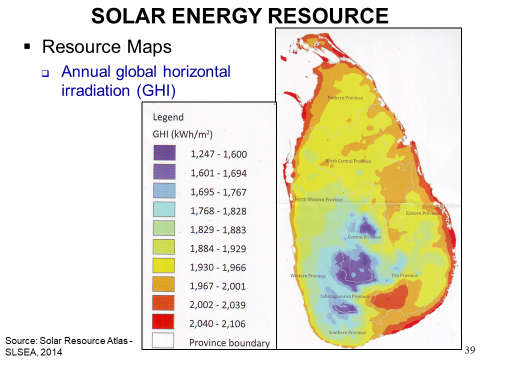
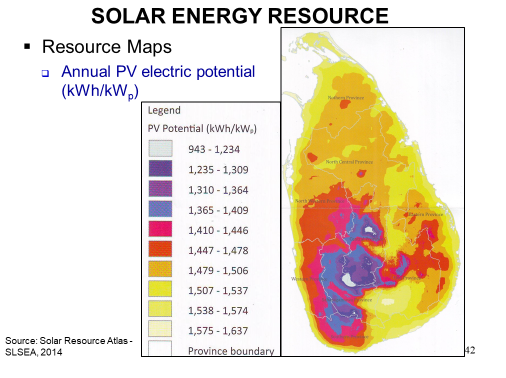
So Sri Lanka is very well endowed with this bounty of nature!
But with all this energy year round why is solar energy not being pursued diligently in Sri Lanka? to answer this question let us covert these units of intensity etc in to numbers that we are familiar with.
Even with the projected demand of 30,890 GWh in 2030 , thus using an average of say 1750 kWh/m2/yr the area required, if we want to get this entire energy form the sun is only 390 square kilometers. Which is only 0.60 % of the total land area of the country. The DG of the SLSEA Dr. Asanka Rodrigo has calculated that this area amounts to only 10 % of the scrub lands which is reported as 1.6 million ha by the Land Use Policy Planning Unit of the Ministry of lands. These still look like a lot of land and let us look at this land issue later on. But then no one is planning to get all our electricity from solar PV. So let us be more pragmatic and look at the current situation as 2030 is a decade away and much could happen before that. The current annual electricity demand is 18542 GWH annually. Suppose we target a contribution of say 25% of this demand instead of the current contribution less than 1%, the same mathematics yield an area requirement of only 53.5 square kilometers or 5350 ha.( Ref Draft LTEGP 2020-2039) Does not sound too daunting does it? But there are other possibilities too which will be discussed later. I hope no one will try to split hairs on these numbers. As you note they are based on forecasts to get the correct perspective of the issues. But I believe that they are in the correct ball park and that too a very small ball park.
But the inescapable reality is that sun shines only during the day even we are lucky to get 12 hours of it, the solar insolation varied during the sunshine hours in a bell shape with the maximum during noon. And there are cloudy days and even a passing cloud would reduce the intensity of energy received.
It is this none firm nature and the diurnal availability which has been the main disadvantage and the barrier for wider exploitation of this unenviable natural resource. Also the cost of solar PV was found prohibitive even 5-10 years ago.
Winds (Solar?) of Change
But all that is in the past. No one even in Sri Lanka could argue that solar energy is the cheapest source for power generation except perhaps wind power and major hydro. Solutions have been found to overcome the problem variability and diurnal nature, in many countries.
This is done in two ways, first by accepting the reality of variable nature and system of forecasting the weather patterns and also taking advantage of the wide distribution of the solar systems, particularly the roof top installations. Thus taken as a combined system and not as single installations, present a less formidable picture. A study has proven that a collection of even ten roof top installations in a city area exhibits this behavior. Of course the utilities must be clever enough to factor in this diversity.
On the other hand the use of storage devices, particularly storage batteries has solved this problem entirely. The most famous utility scale battery installation being the 100 MW battery installed by Tesla in Hornsdale south Australia. Now other utilities are vying with each other to install larger and larger batteries and India too has come in to the scene with a tender for a 100 MW battery. That is of course except for Sri Lanka which opts to remain in the last century when it comes to the electricity sector.
Having said that we in Sri Lanka has the largest battery already installed in the shape of major Hydro reservoirs supporting 1399 MW of power generation capacity. All we lack is the courage and are too backwards in our thinking to recognize this asset and its immense value in conjunction with the literally unlimited solar potential and also coupled with the wind resource.
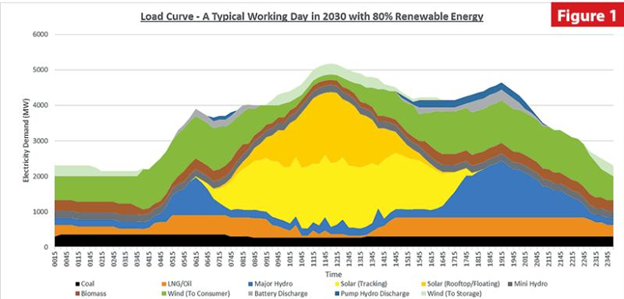
So it is time to talk about how we can use this bounty to the maximum, rather than wasting time discussing why it can’t be done and looking for ghosts under the bed, when the rest of the world has already proven it to be technically and commercially feasible. There was a warning note on safety issues, which reminded me of the reports of the people’s reactions when the first cars came on the road. No doubt safety is an essential issue to be addressed and there are already standards and codes of practice etc. in place to look after such. But we have more fundamental issues to be addressed to move forward to fast track the development of Solar Energy which will be a great boon for all of us in Sri Lanka.
So let us look at the often stated problems.
Lack of Adequate Land
As already shown we need only 0.6 % of the land area even if we depend 100% on solar in 2030. But a more pragmatic vison indicated that we need only 0.33 % of the land for us to elevate the contribution up to 25% by 2030. But even this extent of lands, need not be targeted as there are other options. What should be our target for 2030, if we are to strive to achieve the President’s goal of 80% RE by 2030? As a viable and eminently achievable target I suggest 5000 MW, which would yield 8760 GWH per year or 28% of the total energy demand of 30890 GWH. How much of this can come from solar roof tops? An estimate of 3000 MW has been suggested as shown below.
Total Number of bill paying consumers 6,350,000 ( CEB own statistics 2018)
Assume 20% would opt for roof top solar 1,250,000 consumers
Tottal Solar Capacity @ 3 kW 3,750 MW
So the land requirement is only for the balance 2000 MW of solar parks or only 109 Sq Km or 10900 ha.
But do we need all that area on high land which can be used for other purposes? Our ancient kings and even some of our recent leaders endowed us with another asset. The thousands of reservoirs which would eminently serve our space requirement for the solar parks, with the added advantage of improved conversion efficiency on one hand, and the reduction of evaporation loss of the reservoir water on the other.
Sri Lanka has 62500 ha of reservoir area and 161,500 ha of lagoons dotted all over the country. So even a significant proportion of the area required, can be considered to come from these water bodies making this question of land availability a storm in a tea cup.
How do we handle variability?
The first option is to live with it however, idiotic that may sound. So as mentioned earlier with adequate number of installations there is a certain fraction of firm power that would be available but of course during the sun shine hours. I will leave it to the wizz kids at CEB to work out how to handle this to the best advantage, which of course needs thinking big and planning big to consider a little more than the area covered by a distribution transformer. But also as I said we have the advantage of 1340 MW of hydro power which could be kept entirely away from the grid during day time, as well as shutting down the diesel guzzlers for good. In case someone asks the question, recently South Australia managed the entire day time hours with only solar energy as shown below.
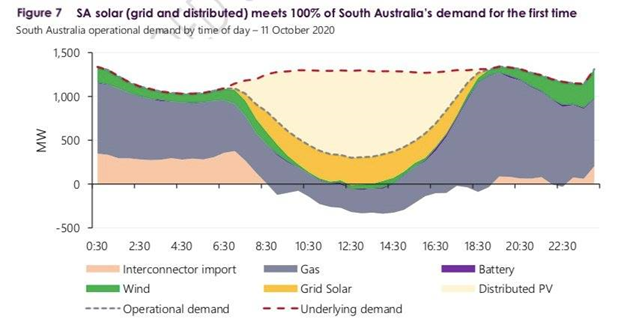
Is there any technical reason why we in Sri Lanka cannot do the same thing, perhaps with a battery/batteries only of adequate capacity to iron out the dips to be expected during the day and to manage the night peak as shown below. That’s the challenge we must accept.
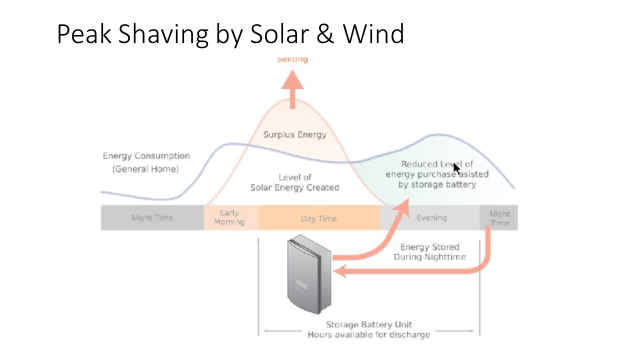
Where are we now?
It is not all gloom and negative sentiments. Over the past few years many things have been moving forward albeit much too slowly for our liking. We have now over 300 MW of grid connected Solar PV roof top installations by about 25,000 consumers and the number is rising. Added to that are over 50 MW of solar parks already connected and if things workout, at least some out of the 300 MW of 1 MW scale solar parks already tendered for should get built.
Sri Lanka can be proud of being most innovative and progressive by the introduction of the net metering system further improved by the three systems under the Surya Bala Sangraamaya. This is the most important shift in policy which led to the exponential growth in the solar PV roof top , which brought in its , many more spin off benefits too many to list here. Therefore Sri Lanka should salute those who had the courage to bring in this legislation, whoever wishes to take credit for it. It is the responsibility of those claiming parentage of this innovation to ensure it is not allowed to be sabotaged as unfortunately some people are trying , including those in authority who fail to appreciate its value and immense potential. It is sad to see propaganda based on entirely incorrect numbers perhaps purposely designed to deceive, being used in this disruptive campaigns.
What does the immediate future offer us?
If the present format of the Surya Bala Sangraamaya is allowed to continue, including the tariff structure , a most ambitious and visionary program has been proposed by the State Minister to install 100,000 rooftop solar PV systems targeting the Samurdhi Recipients. The capacity of each is estimated to be about 5-6 kW under the Net Plus scheme. Leveraging on the ADB funded loan scheme and an attractive low interest rate of 4%, this project can be entirely funded by the loan scheme and has the greatest advantage of the loan installment payments being made from the monthly income of exporting the generated energy to the national grid. It is also expected that the consumer will have a surplus in excess of the normal Samurdhi payment he would have otherwise received from the government, which will now not be forthcoming. Once the loan is paid up the consumer will receive a very substantial monthly income way above the Rs 2,500, he would otherwise have received, and would also have the satisfaction of being a contributor to the national energy mix thus joining the growing band of “ Prosumers”
This is indeed a win-win opportunity where by the country will gain at least 500 MW addition to the grid, without any capital expenditure by the treasury and an added saving of Rs 3000 Million every year by offsetting the 100,000 Samurdhi payments. The CEB too will make a saving by the avoidance of equivalent amount of expensive oil based power generation. We only hope that the CEB will proactively work towards ensuring the success of this project without trotting out the usual slogans.

The most tantalizing target is the 1.4 Million Samurdhi recipients who can be up lifted from eternal poverty at no cost to the government.
The State Ministers program deserves the proactive support of all concerned by removing any road blocks that could appear in implementing this courageous by daunting project.
The CEB must be congratulated for launching a similar innovative project in parallel to clear the way for local investors to implement 10,000 mini solar parks, targeting the 100 kW distribution transformers dotted round the country. It is understood that they have already identified 7000 transformers that could be used for this scheme. Thus the possibility of adding a further 1000 MW of Solar power to the grid is already on the cards with the blessing of the CEB who are best placed to ensure its success. Perhaps there could be room to further expand this scheme.
Therefore if the above two schemes are implemented, not deterred by any minor glitches which should be addressed proactively, Sri Lanka too can play catch me with our neighbors in the race for solar power.
Several other larger solar parks have been in the planning for some time. The 100 MW solar park in Siyambaladuwa is expected to be tendered for soon.
The major challenge ahead
While the success of the above projects give us hope and encouragement that at last Sri Lanka too is taking some action to harness the bounty of solar energy, all these are targeting the electricity sector. But the fact is that the Electricity sector’s contribution to the total national energy demand has stagnated at about 11% over the years.
No doubt that it is serving a most important national need, but the fact that electricity can serve all other demands for energy more efficiently and thus offers an opportunity to expand its contribution, seems to have escaped attention.
As much as the recent advances both in technology and commercial aspects have improved the viability of solar energy, there has also been the parallel advancement of the Electrical Vehicle Technologies. Thus the foray in to transport energy is a challenge that the CEB can no longer ignore.
In the national context Sri Lanka’s problems with the drain on foreign exchange as well the environmental degradation is due to the over dependence on imported fossil fuels. In fact these negative impacts are more due to transport sector than in the electricity generation sector. Thus we have been ignoring the elephant in the room with hardly any mention being made of any proposals for electrification of transport. Having said that it must be acknowledged that the national energy policy gazetted by the Ministry of Power and Energy in August 2019, projects a target of achieving 25% of all light vehicles being converted to electricity by 2023. But as all policies go in Sri Lanka, this target too is limited to paper, even having gone as far as to be gazetted. I will bet my bottom dollar that the present ministers are not even aware of this policy statement. The unfortunate situation is that the CEB itself does not seem to have proactively used this policy to enhance their share in the energy pie.
Since this note is on the potential of maximum usage of solar power, that we in Sri Lanka are richly endowed with, I would like to share my experience in successfully tapping this source of energy entirely free of cost for both my electricity and transport.
Over the last 20 months I have not had to pay any electrical bills, nor buy a single liter of petrol , thanks to my roof top solar PV system and the EV I was lucky to purchase, before the then government saw it fit to increase the taxes for the EVs to be no longer affrodable, which would have blocked my opportunity. Also before any one claims that I have deprived the CEB from income by this, let me assure you that I am not a high end consumer and the CEB gains by my generating my own electricity and also exporting some for the CEB to reduce the dependence on oil based generation much more costly than what they pay me. That’s is how the investment became viable for me by the saving in the petrol expense. While I have not calculated the saving in Foreign exchange, I believe that this demonstrates the way ahead to wean Sri Lanka away from the unhealthy dependence on imported fossil fuels, which is 100% in case of the Transport fuels.
May I invite all of you to explore the possibility of emulating this possibility and thus become “Prosumers” in a much more meaningful way. The illustration below copied from a publication by SLSEA would point the way by which the CEB can plan the future by which they would become the dominant player in the energy sector not limited to Electricity. The concept of vehicle to grid (V2G) , whereby the batteries in the large number of vehicles which are parked in the hot sun most of the day, constitutes a resource as important as the sun itself. Will we be clever enough to appreciate this synergy and exploit it?

Our energy future needs to be “Electrical”. Solar energy paves the way and could also become the most important player by democratizing the electrical generation industry.
This note is designed only to highlight the great opportunity awaiting us, only if we have the courage and the vision to exploit same for Sri Lanka. The feasibility of doing so has been proven all over the world, even where the resource is much less pronounced. Do we as professionals accept this challenge to justify our claim for excellence and national service?
 Eng Parakrama Jayasinghe
Eng Parakrama Jayasinghe
Parajaysinghe@gmail.com





